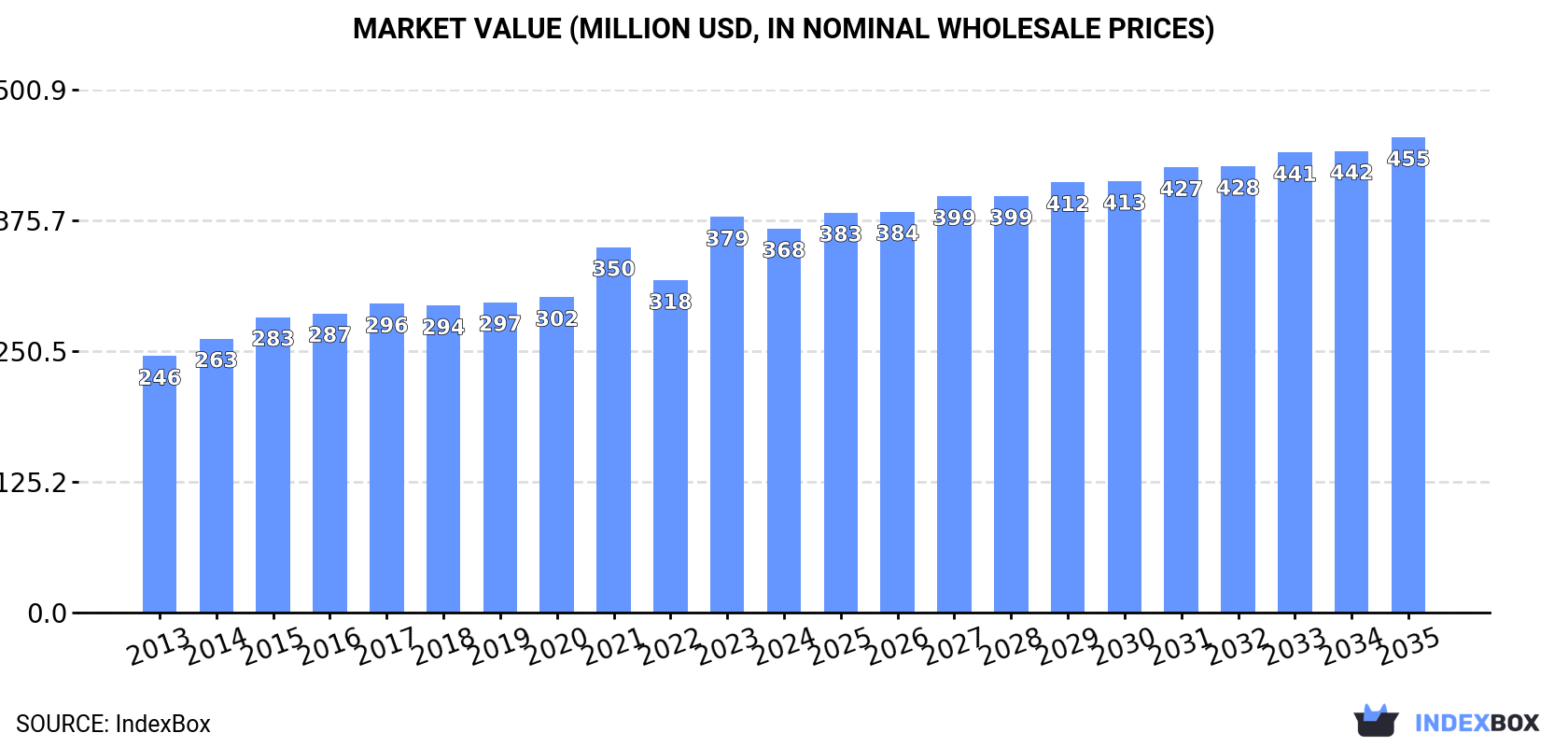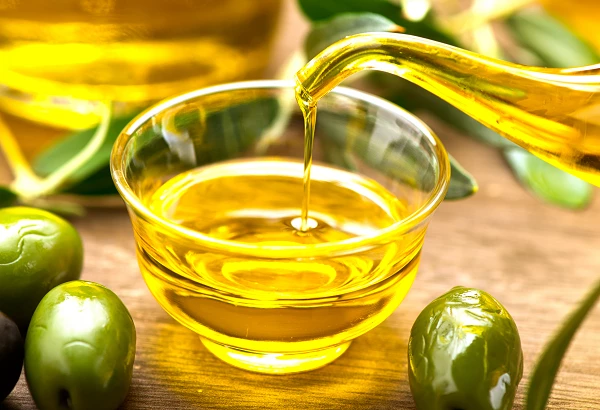Oct 25, 2025
IndexBox has just published a new report: GCC – Refined Olive Oil – Market Analysis, Forecast, Size, Trends And Insights.
This market analysis provides a comprehensive overview of the refined olive oil sector in the Gulf Cooperation Council (GCC) region. In 2024, the market stood at 111K tons in volume and $368M in value. Saudi Arabia dominates both consumption and production, accounting for approximately 70% of the total volume. The market is forecast to grow at a slower pace over the next decade, with volume projected to reach 117K tons by 2035 at a CAGR of +0.5%, while value is expected to grow at a CAGR of +2.0% to $455M. The region is largely self-sufficient in production (108K tons in 2024), with imports declining significantly to 4.6K tons and exports surging by 114% to 2K tons. Key trends include varying growth rates among member countries, with Oman showing the highest per capita consumption and Qatar experiencing the fastest import growth.
Key Findings
Saudi Arabia is the dominant market leader, accounting for 70% of GCC’s refined olive oil consumption and productionMarket volume is forecast for slow growth with a +0.5% CAGR, reaching 117K tons by 2035Market value is expected to increase at a +2.0% CAGR, projected to reach $455M by 2035Oman leads in per capita consumption at 2.3 kg per person, the highest in the regionThe United Arab Emirates is the primary exporter, responsible for 97% of the region’s refined olive oil exportsMarket Forecast
Driven by increasing demand for refined olive oil in GCC, the market is expected to continue an upward consumption trend over the next decade. Market performance is forecast to decelerate, expanding with an anticipated CAGR of +0.5% for the period from 2024 to 2035, which is projected to bring the market volume to 117K tons by the end of 2035.
In value terms, the market is forecast to increase with an anticipated CAGR of +2.0% for the period from 2024 to 2035, which is projected to bring the market value to $455M (in nominal wholesale prices) by the end of 2035.
 ConsumptionGCC’s Consumption of Refined Olive Oil
ConsumptionGCC’s Consumption of Refined Olive Oil
In 2024, the amount of refined olive oil consumed in GCC stood at 111K tons, stabilizing at the previous year. The total consumption volume increased at an average annual rate of +3.0% from 2013 to 2024; however, the trend pattern indicated some noticeable fluctuations being recorded in certain years. The most prominent rate of growth was recorded in 2021 when the consumption volume increased by 8.2% against the previous year. The volume of consumption peaked in 2024 and is expected to retain growth in years to come.
The size of the refined olive oil market in GCC declined slightly to $368M in 2024, which is down by -2.9% against the previous year. This figure reflects the total revenues of producers and importers (excluding logistics costs, retail marketing costs, and retailers’ margins, which will be included in the final consumer price). The market value increased at an average annual rate of +3.7% over the period from 2013 to 2024; however, the trend pattern indicated some noticeable fluctuations being recorded throughout the analyzed period. As a result, consumption reached the peak level of $379M, and then contracted slightly in the following year.
Consumption By Country
The country with the largest volume of refined olive oil consumption was Saudi Arabia (77K tons), comprising approx. 70% of total volume. Moreover, refined olive oil consumption in Saudi Arabia exceeded the figures recorded by the second-largest consumer, Oman (13K tons), sixfold. The United Arab Emirates (12K tons) ranked third in terms of total consumption with an 11% share.
From 2013 to 2024, the average annual growth rate of volume in Saudi Arabia amounted to +2.9%. In the other countries, the average annual rates were as follows: Oman (+6.3% per year) and the United Arab Emirates (+0.9% per year).
In value terms, Saudi Arabia ($267M) led the market, alone. The second position in the ranking was taken by Oman ($44M). It was followed by the United Arab Emirates.
In Saudi Arabia, the refined olive oil market expanded at an average annual rate of +3.6% over the period from 2013-2024. In the other countries, the average annual rates were as follows: Oman (+7.0% per year) and the United Arab Emirates (+0.4% per year).
The countries with the highest levels of refined olive oil per capita consumption in 2024 were Oman (2.3 kg per person), Saudi Arabia (2.1 kg per person) and Kuwait (1.3 kg per person).
From 2013 to 2024, the most notable rate of growth in terms of consumption, amongst the leading consuming countries, was attained by Oman (with a CAGR of +2.7%), while consumption for the other leaders experienced more modest paces of growth.
ProductionGCC’s Production of Refined Olive Oil
In 2024, approx. 108K tons of refined olive oil were produced in GCC; growing by 2.6% against the previous year. In general, production showed a temperate increase. The pace of growth was the most pronounced in 2022 when the production volume increased by 137%. As a result, production attained the peak volume of 239K tons. From 2023 to 2024, production growth remained at a somewhat lower figure.
In value terms, refined olive oil production contracted to $357M in 2024 estimated in export price. Overall, production saw a noticeable increase. The most prominent rate of growth was recorded in 2022 when the production volume increased by 108%. As a result, production reached the peak level of $687M. From 2023 to 2024, production growth failed to regain momentum.
Production By Country
Saudi Arabia (76K tons) constituted the country with the largest volume of refined olive oil production, comprising approx. 70% of total volume. Moreover, refined olive oil production in Saudi Arabia exceeded the figures recorded by the second-largest producer, the United Arab Emirates (13K tons), sixfold. Oman (12K tons) ranked third in terms of total production with a 12% share.
In Saudi Arabia, refined olive oil production expanded at an average annual rate of +3.5% over the period from 2013-2024. In the other countries, the average annual rates were as follows: the United Arab Emirates (+1.9% per year) and Oman (+7.1% per year).
ImportsGCC’s Imports of Refined Olive Oil
In 2024, overseas purchases of refined olive oil decreased by -26% to 4.6K tons, falling for the second year in a row after two years of growth. In general, imports recorded a pronounced curtailment. The pace of growth appeared the most rapid in 2016 with an increase of 32% against the previous year. As a result, imports attained the peak of 15K tons. From 2017 to 2024, the growth of imports failed to regain momentum.
In value terms, refined olive oil imports contracted notably to $18M in 2024. Over the period under review, imports showed a pronounced downturn. The pace of growth was the most pronounced in 2022 when imports increased by 64% against the previous year. Over the period under review, imports attained the maximum at $47M in 2016; however, from 2017 to 2024, imports remained at a lower figure.
Imports By Country
In 2024, Saudi Arabia (1.9K tons) and Kuwait (1.3K tons) were the main importers of refined olive oil in GCC, together resulting at near 69% of total imports. It was distantly followed by the United Arab Emirates (584 tons), Qatar (492 tons) and Oman (210 tons), together achieving a 28% share of total imports. Bahrain (129 tons) held a minor share of total imports.
From 2013 to 2024, the most notable rate of growth in terms of purchases, amongst the leading importing countries, was attained by Qatar (with a CAGR of +30.3%), while imports for the other leaders experienced mixed trends in the imports figures.
In value terms, the largest refined olive oil importing markets in GCC were Saudi Arabia ($6.8M), Kuwait ($4M) and the United Arab Emirates ($3.5M), together comprising 79% of total imports. Qatar, Oman and Bahrain lagged somewhat behind, together accounting for a further 21%.
Among the main importing countries, Qatar, with a CAGR of +41.6%, saw the highest rates of growth with regard to the value of imports, over the period under review, while purchases for the other leaders experienced a decline in the imports figures.
Import Prices By Country
In 2024, the import price in GCC amounted to $3,934 per ton, with a decrease of -21% against the previous year. Overall, the import price, however, saw a relatively flat trend pattern. The pace of growth was the most pronounced in 2022 when the import price increased by 29%. Over the period under review, import prices reached the peak figure at $4,979 per ton in 2023, and then dropped dramatically in the following year.
There were significant differences in the average prices amongst the major importing countries. In 2024, amid the top importers, the country with the highest price was Oman ($6,817 per ton), while Qatar ($3,035 per ton) was amongst the lowest.
From 2013 to 2024, the most notable rate of growth in terms of prices was attained by Qatar (+8.7%), while the other leaders experienced more modest paces of growth.
ExportsGCC’s Exports of Refined Olive Oil
In 2024, refined olive oil exports in GCC soared to 2K tons, rising by 114% compared with the previous year’s figure. In general, exports recorded a resilient expansion. The pace of growth appeared the most rapid in 2022 when exports increased by 11,064% against the previous year. As a result, the exports reached the peak of 138K tons. From 2023 to 2024, the growth of the exports remained at a somewhat lower figure.
In value terms, refined olive oil exports skyrocketed to $3.9M in 2024. Overall, exports continue to indicate notable growth. The pace of growth was the most pronounced in 2022 when exports increased by 2,981%. As a result, the exports reached the peak of $96M. From 2023 to 2024, the growth of the exports failed to regain momentum.
Exports By Country
The United Arab Emirates dominates exports structure, finishing at 1.9K tons, which was approx. 97% of total exports in 2024. Kuwait (49 tons) followed a long way behind the leaders.
The United Arab Emirates was also the fastest-growing in terms of the refined olive oil exports, with a CAGR of +9.2% from 2013 to 2024. At the same time, Kuwait (+1.6%) displayed positive paces of growth. The United Arab Emirates (+28 p.p.) significantly strengthened its position in terms of the total exports, while the shares of the other countries remained relatively stable throughout the analyzed period.
In value terms, the United Arab Emirates ($3.6M) remains the largest refined olive oil supplier in GCC, comprising 92% of total exports. The second position in the ranking was held by Kuwait ($268K), with a 6.9% share of total exports.
From 2013 to 2024, the average annual growth rate of value in the United Arab Emirates stood at +8.1%.
Export Prices By Country
In 2024, the export price in GCC amounted to $2,000 per ton, waning by -44.7% against the previous year. Overall, the export price saw a mild descent. The pace of growth was the most pronounced in 2023 when the export price increased by 422% against the previous year. As a result, the export price reached the peak level of $3,617 per ton, and then shrank rapidly in the following year.
Prices varied noticeably by country of origin: amid the top suppliers, the country with the highest price was Kuwait ($5,470 per ton), while the United Arab Emirates stood at $1,895 per ton.
From 2013 to 2024, the most notable rate of growth in terms of prices was attained by Kuwait (+0.5%).
Source: IndexBox Market Intelligence Platform


Dining and Cooking